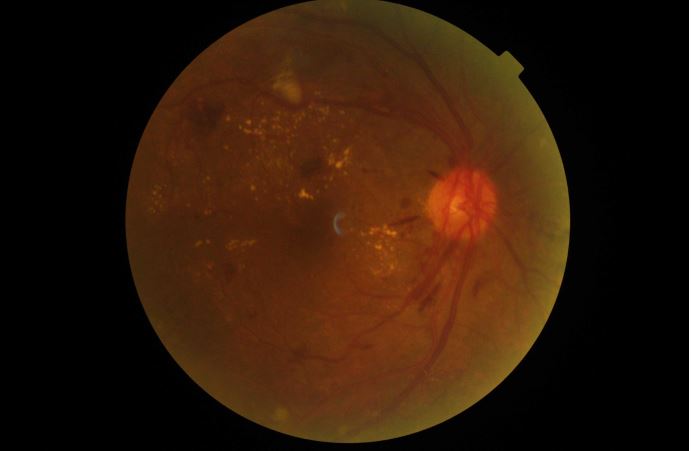Diabetic retinopathy in Nepal: An update

Related content
Magnitude and awareness
The Nepal Diabetes Association reported that in urban areas diabetes affects approximately 15% of people aged 20 years and above.1 Studies reported Diabetic Retinopathy (DR) in 19-47% of diabetic patients in Nepal,2-5 which is similar to that in India. A recent study in India quoted the prevalence rate of diabetic retinopathy to be 21.27% in diabetic patients with a range of 12.27% in the central zone and 34.06% in the north zone.6
In Nepal, less than 30% or people having diabetes are aware of diabetic eye disease.7 Almost 50% of cases never had a retina evaluation despite having lived with diabetes for more than 10 years.8
Diabetic eye care services in Nepal are not integrated with comprehensive diabetes management. Limited access to DR screening and vitreo-retinal services are the major barriers for service utilisation. As a result, people with diabetes often reach eye health providers with late stage, sight-threatening DR.9
DR screening
Timely and periodic screening is important for the prevention of retinopathy. At present DR is screened by ophthalmologists in Nepal. However, trained mid-level ophthalmic personnel can reliably screen for DR and identify cases requiring referral. A recent study 10 showed that allied ophthalmic personnel with training could be the first ones to screen for DR and to refer vision-threatening conditions. This modality may reduce the workload of the ophthalmologist and can be useful in other developing countries.
DR screening has to be effectively integrated into routine care for people with diabetes in all major hospitals in Nepal, through a partnership with eye health service providers. Formal training of health professionals involved in diabetes management, including endocrinologists and ophthalmologists, through Continuing Medical Education programmes is crucial.
Resources to address sight-threatening diabetic retinopathy
Sight- threatening diabetic retinopathy which requires intervention is referred to hospitals where laser services and vitreo-retina set-up are available. Out of twenty-two eye hospitals only nine have a surgical set-up and a few have laser facilities according to the Apex body for Eye Health in Nepal.
Rehabilitation
Visually impaired diabetics have specific needs which must be addressed. In such cases, utilising remaining vision to its fullest potential becomes paramount. Rehabilitation of persons with DR-induced visual disabilities is provided by a few low vision clinics in select tertiary eye hospitals in Nepal.
Conclusion
Diabetes is a growing problem in Nepal, but awareness of retinopathy is very poor. The public should be sensitised about diabetic eye diseases. There are limited resources, however mid-level ophthalmic personnel can be trained to screen and refer sight-threatening retinopathy. There is also a need for rehabilitation of visually impaired persons living with diabetes.
References
- Singh DL &Bhattarai MD. High prevalence of diabetes and impaired fasting glycaemia in urban Nepal. Diabetic medicine 2003; 20:170-171
- Thapa SS, Thapa R, Paudyal I, Khanal S, Aujla J, Paudyal G, et al. Prevalence and pattern of Vitreo-retinal disorders inNepal: the Bhaktapur glaucoma study. BMC Ophthalmology. 2013, 13, 9. doi:10.1186/1471-2415-13-9
- Rizyal A. Ocular manifestations in diabetes mellitus: an experience at Nepal Medical College Teaching Hospital. Nepal Med Coll J. 2004;6:136 -138.
- Shrestha S, Malla OK, Karki DB, Byanju RN. Retinopathy in diabetic population. Kathmandu Univ Med J. 2007;5:204-209.
- Shrestha RK. Ocular manifestations in diabetes, a hospital based prospective study. Nepal Med Coll J. 2011;13:254—256.
- Salil S Gadkari, Quresh B Maskati, Barun Kumar Nayak.Prevalence of diabetic retinopathy in India: The All India Ophthalmological Society Diabetic Retinopathy Eye Screening Study 2014. Indian Journal of Ophthalmology.2016; 64(1): 38–44.
- Shrestha MK, Guo CW, Maharjan N, Gurung R and Ruit S. Health literacy of common ocular diseases in Nepal. BMC Ophthalmology. 2014, 14:2
- Thapa R, Paudyal G, Maharjan N, Bernstein PS. Demographics and awareness of diabetic retinopathy among diabetic patients attending the vitreo-retina service at tertiary eye care centre of Nepal. Nepal J Ophthalmol. 2012; 4(7):10-16
- Paudyal G, Shrestha MK, Meyer JJ, Thapa R, Gurung R and Ruit S. “Prevalence of diabetic retinopathy following a community screening for diabetes.”. Nepal Med Coll J. 2008; 10(3): 160-163
- Thapa R, Bajimaya S, Bouman R, Paudyal G, Khanal S, Tan S, et al. Intra- and inter-rater agreement between an ophthalmologist and mid-level ophthalmic personnel to diagnose retinal diseases based on fundus photographs at a primary eye center in Nepal: the Bhaktapur Retina Study. BMC Ophthalmol. 2016; 16: 112. DOI:10.1186/s12886-016-0295-0.
